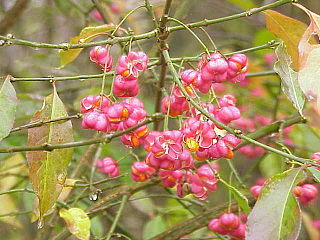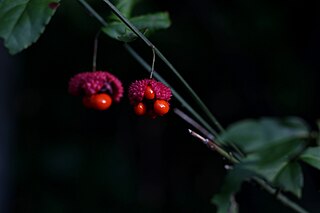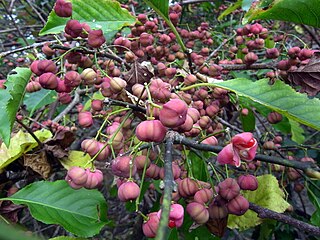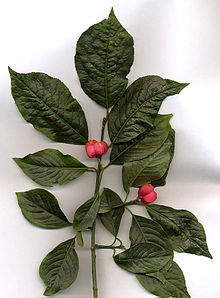
Fragaria is a genus of flowering plants in the rose family, Rosaceae, commonly known as strawberries for their edible fruits. There are more than 20 described species and many hybrids and cultivars. The most common strawberries grown commercially are cultivars of the garden strawberry, a hybrid known as Fragaria × ananassa. Strawberries have a taste that varies by cultivar, and ranges from quite sweet to rather tart. Strawberries are an important commercial fruit crop, widely grown in all temperate regions of the world.

A shrub or bush is a small-to-medium-sized perennial woody plant. Unlike herbaceous plants, shrubs have persistent woody stems above the ground. Shrubs can be either deciduous or evergreen. They are distinguished from trees by their multiple stems and shorter height, less than 6–10 m (20–33 ft) tall. Small shrubs, less than 2 m (6.6 ft) tall are sometimes termed as subshrubs. Many botanical groups have species that are shrubs, and others that are trees and herbaceous plants instead.

Forsythia, is a genus of flowering plants in the olive family Oleaceae. There are about 11 species, mostly native to eastern Asia, but one native to southeastern Europe. Forsythia – also one of the plant's common names – is named after William Forsyth.

Deutzia is a genus of about 60 species of flowering plants in the family Hydrangeaceae, native to eastern and central Asia, and Central America and also Europe. By far the highest species diversity is in China, where 50 species occur.

The Celastraceae are a family of 98 genera and 1,350 species of herbs, vines, shrubs and small trees, belonging to the order Celastrales. The great majority of the genera are tropical, with only Celastrus, Euonymus and Maytenus widespread in temperate climates, and Parnassia (bog-stars) found in alpine and arctic climates.

Symphoricarpos, commonly known as the snowberry, waxberry, or ghostberry, is a small genus of about 15 species of deciduous shrubs in the honeysuckle family, Caprifoliaceae. With the exception of the Chinese coralberry, S. sinensis, which is indigenous to western China, all species are native to North and Central America. The name of the genus is derived from the Ancient Greek words συμφορεῖν (sumphoreîn), meaning "to bear together", and καρπός (karpós), meaning "fruit". It refers to the closely packed clusters of berries the species produces.

Euonymus japonicus is a species of flowering plant in the family Celastraceae, native to Japan, Korea and China. It is an evergreen shrub or small tree growing to 2–8 m tall, with opposite, oval leaves 3–7 cm long with finely serrated margins. The flowers are inconspicuous, greenish-white, 5 mm diameter. In autumn, orange fruit hangs below the flaring pink seed coverings.

Euonymus europaeus, the spindle, European spindle, or common spindle, is a species of flowering plant in the family Celastraceae, native to much of Europe, where it inhabits the edges of forest, hedges and gentle slopes, tending to thrive on nutrient-rich, chalky and salt-poor soils. It is a deciduous shrub or small tree.

Euonymus alatus, known variously as winged spindle, winged euonymus, or burning bush, is a species of flowering plant in the family Celastraceae, native to central and northern China, Japan, and Korea.

Euonymus atropurpureus is a species of shrub in the bittersweet family. It has the common names American wahoo, eastern wahoo, burningbush and hearts bursting with love. It is native to eastern North America.

Euonymus fortunei, the spindle, Fortune's spindle, winter creeper or wintercreeper, is a species of flowering plant in the family Celastraceae, native to east Asia, including China, Korea, the Philippines and Japan. E. fortunei is highly invasive and damaging in the United States, causing the death of trees and forest in urban areas.

Lonicera maackii, the Amur honeysuckle, is a species of honeysuckle in the family Caprifoliaceae that is native to temperate eastern Asia; specifically in northern and western China south to Yunnan, Mongolia, Primorsky Krai in southeastern Siberia, Korea, and, albeit rare there, central and northern Honshū, Japan.

Euonymus pendulus is a species of Euonymus native to the Himalaya region, from Pakistan east to northern Assam.

Euonymus acanthocarpus is a species of flowering plant in the family Celastraceae. It is endemic to China. It has a scattered distribution in forest habitat.

Euonymus americanus is a species of flowering plant in the family Celastraceae. Common names include strawberry bush, American strawberry bush, bursting-heart, hearts-a-bustin, and hearts-bustin'-with-love. It is native to the eastern United States, its distribution extending as far west as Texas. It has also been recorded in Ontario.

Prunus tomentosa is a species of Prunus native to northern and western China, Korea, Mongolia, and possibly northern India. Common names for Prunus tomentosa include Nanjing cherry, Korean cherry, Manchu cherry, downy cherry, Shanghai cherry, Ando cherry, mountain cherry, Chinese bush cherry, and Chinese dwarf cherry.

Euonymus hamiltonianus, known by the common names Hamilton's spindletree, Himalayan spindle, and Siebold's spindle is a species of flowering plant in the family Celastraceae. It is native to Asia, where it is distributed in Afghanistan, Russia, China, Japan, Korea, India, Nepal, Pakistan, Bhutan, Thailand, and Myanmar. This is one of the most common Euonymus species. It is cultivated in gardens and landscapes in other parts of the world.

Euonymus phellomanus is a species of flowering plant in the family Celastraceae, native to China. It is one of several species within Euonymus called spindle or spindle tree. A substantial deciduous shrub growing to 2–4 m (6.6–13.1 ft) tall by 2.5 m (8.2 ft) broad, it produces insignificant yellow-green flowers in May followed by brilliant pink fruits in autumn. The fruits sometimes break open to reveal bright orange seeds. A notable feature is the rough corky bark which with age develops "wings" clothing the length of each branch. A similar effect is seen in the related Euonymus alata. This feature gives rise to a name occasionally used, the corktree.

Euonymus sachalinensis, the flat-stalked spindle, is a species of flowering plant in the family Celastraceae, native to Japan, China, Korea, and the Island of Sakhalin. Growing to 2.5 m (8.2 ft) tall and broad, it is a deciduous shrub notable for its leaves turning red in autumn, and its red fruit which splits open to reveal orange seeds. Exceptional specimens, such as the one in the Hørsholm Arboretum, Copenhagen University, can become trees up to 4 m (13 ft) in height.

Euonymus oxyphyllus, the Korean spindle tree, is a species of flowering plant in the family Celastraceae, native to central and eastern China, Manchuria, Korea, Japan and the Kurils. It is a shrub or small tree typically reaching 2.5 m (8 ft). The Royal Horticultural Society considers it to be a good tree for smaller gardens, especially for its colorful Autumn foliage and fruits.























